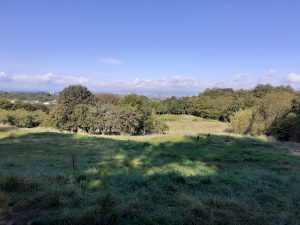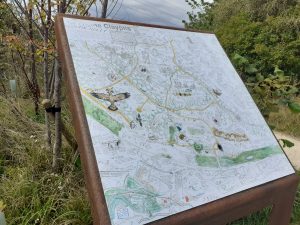Pass marks all around – by Jim Jeffrey
Since 2016, The Green Infrastructure Fund led by NatureScot has allocated almost £15m of ERDF funding to projects creating multifunctional green infrastructure in some of the most deprived areas of urban Scotland. As the programme nears completion, and following a recent CIEEM Scottish section site visit to two of the sites, Jim Jeffrey, Communications Officer with NatureScot’s Structural Funds team, reflects on what the fund has achieved.

Several of the projects we have supported through the ERDF Green Infrastructure Fund are nearing completion. One or two are already over the finishing line. Regardless of the stage the projects have currently reached it is clear that they are going to have a hugely long-term beneficial outcome. With the schools out on holiday it got me reflecting on the annual cycle of report cards, and with that in mind here’s an update on the progress of the raft of Green Infrastructure projects we have been involved with.
Fernbrae Meadows: South Lanarkshire Council and the local community are rightly proud of the transformation of this neglected golf course into a thriving urban park. What was once a barrier between communities is now an asset for all, and the use of the park by schools, walking groups, allotment holders and those simply wanting a relaxing time surrounded by nature is evidence of a stunning success. It is a cause for celebration that this site has now gained Local Nature Reserve status and has an active Friends of group who are helping to monitor biodiversity on the site.

Canal & North Gateway: Work around the canal is all but complete now, and the local Nature Reserve at Claypits has earned rave reviews from locals and visitors alike. What was once a degraded potential no-go area is now opened up into an attractive greenspace with active travel routes, recreational opportunities and a sense of community to the fore. Add to the mix the remarkable and innovative Smart Canal element and you get a project that has excelled on various fronts.
Melfort Park: The transformation from bulldozed primary school site to thriving urban park is complete. The community growing areas with commanding views out over the Clyde to Renfrewshire are stunning. Accessible to all, the park is a new focal point. Add to the mix the ease of walking or wheeling into the centre of Clydebank and the use of the site by local primary schools and you have a remarkable recovery for a plot that was a neglected eyesore.
Middlefield Greenspace: This open greenspace in northern Aberdeen is now a busy multi-functional greenspace. The introduction of a series of smooth all abilities paths, the uncovering of a local burn, the addition of meadows and wetland areas which help mitigate flooding, play areas and linking of local communities has been enthusiastically received. The change in the site is remarkable and locals are making great use of the revamped area.
Halfway Community Park: In taking a bland and uninviting greenspace at the front of Cardonald’s Moss Heights, and creating a welcoming community park the local housing association have hugely improved access and use around this site. The removal of traffic from the area between housing and the park was an inspired move and the inclusion of smartly planted areas, sympathetic landscaping of greenspaces and successful involvement of the local community have all come up trumps.
Greater Easterhouse: Where there were once abandoned red blaze football pitches and neglected rubbish strewn land there is now a fantastic greenspace. Cycling and walking routes have been opened up, the area has been completely re-landscaped and nearby residents now have an open and fantastic greenspace to enjoy. Even the local fossorial water vole population have been catered for.
So much for the raft of Phase One projects. Phase Two projects are now underway, and again that mix of bringing disused land back into use, connecting communities and providing welcoming greenspaces for people and nature alike is to the fore.

Cunningar Loop: Once a city dumping ground, this fantastic park in the East End of Glasgow builds upon the legacy of the nearby Commonwealth Games sites. The park is thriving and with a series of welcoming paths, community hub and a range of exercise facilities it is sure to be an admired site in years to come.
Malls Mire: Lying in the south side of Glasgow the transformation of a former industrial site into a large and welcoming urban park is a roaring success. With new housing and a popular urban woodland site lying adjacent this is a park that is well-used and well designed, easing active travel between key Toryglen housing and commercial areas and has improved habitat quality and connectivity.
The Treehouse: This Inverness-based project led by Scottish Canals has transformed a derelict area with a new building with community facilities which will provide the opportunity for local people to take part in activities to increase their connection with nature. The project has also improved access routes into the nearby Merkinch LNR and integrated green infrastructure into the design of the building including a green roof and raingardens. The communities around this site share a set of aspirations that includes encouraging community use, improving neighbourhoods, removing social barriers and creating havens for people and nature.
We were delighted recently to invite members of CIEEM (The Chartered Institute of Ecology and Environmental Management) to visit the sites at Fernbrae and Claypits. As Dr. Caroline McParland, vice president of CIEEM Scotland, noted afterwards, “I particularly enjoyed hearing about the social aspects of the projects and how both sites had evolved from being places to avoid, to being places to enjoy. It brought home to me some of the challenges – and successes – in making places that work for nature and people.
“Nature-based solutions/GI are increasingly a ‘no-brainer’ approach as they offer so many different benefits for health, well-being and placemaking, in addition to their ‘primary’ functions.”
The transformed sights are clearly inclusive and popular.
Arthur Keller heads up the Structural Funds team at NatureScot, which manages the Green Infrastructure Strategic Intervention Fund on behalf of Scottish Government and the European Regional Development Fund. He is delighted that the fund has been able to support projects which can create multi-functional greenspaces in areas desperately seeking to tackle a range of pressing issues. “We face many challenges in the disadvantaged areas of our towns and cities,” he notes. “These include declining industries, social inequality, chronic health problems and poor quality environments. This fund supports projects which will invest in these areas, creating successful greenspaces to deliver multiple benefits and act as a catalyst for urban regeneration.”
As report cards go that’s a good one by any measure.
Blog posts on the CIEEM website are the views and opinions of the author(s) credited. They do not necessarily represent the views or position of CIEEM. The CIEEM blog is intended to be a space in which we publish thought-provoking and discussion-stimulating articles. If you’d like to write a blog sharing your own experiences or views, we’d love to hear from you at SophieLowe@cieem.net.
